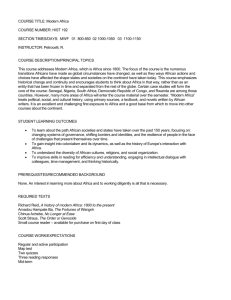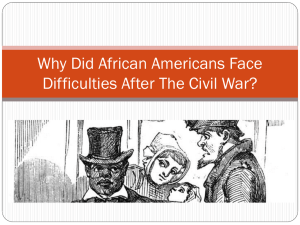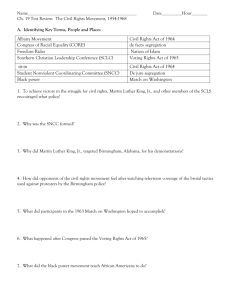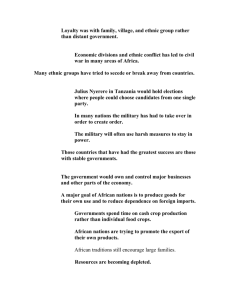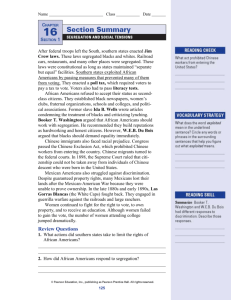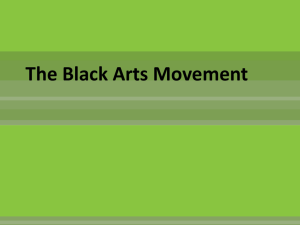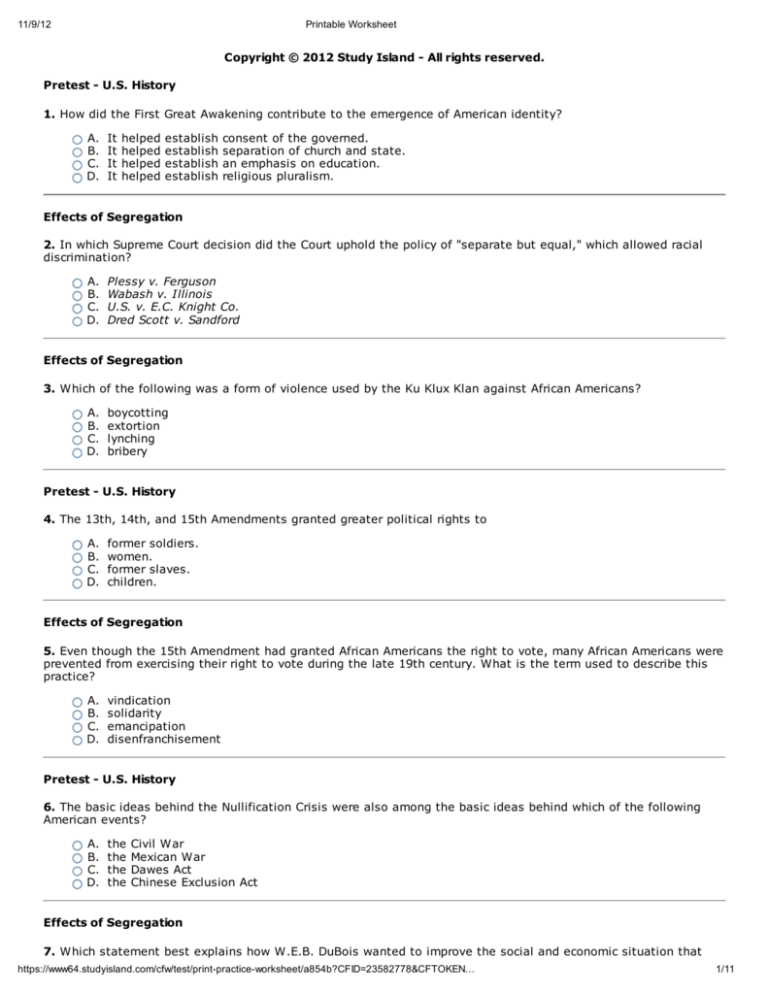
11/9/12
Printable Worksheet
Copyright © 2012 Study Island - All rights reserved.
Pretest - U.S. History
1. How did the First Great Awakening contribute to the emergence of American identity?
A.
B.
C.
D.
It
It
It
It
helped
helped
helped
helped
establish
establish
establish
establish
consent of the governed.
separation of church and state.
an emphasis on education.
religious pluralism.
Effects of Segregation
2. In which Supreme Court decision did the Court uphold the policy of "separate but equal," which allowed racial
discrimination?
A.
B.
C.
D.
Plessy v. Ferguson
Wabash v. Illinois
U.S. v. E.C. Knight Co.
Dred Scott v. Sandford
Effects of Segregation
3. Which of the following was a form of violence used by the Ku Klux Klan against African Americans?
A.
B.
C.
D.
boycotting
extortion
lynching
bribery
Pretest - U.S. History
4. The 13th, 14th, and 15th Amendments granted greater political rights to
A.
B.
C.
D.
former soldiers.
women.
former slaves.
children.
Effects of Segregation
5. Even though the 15th Amendment had granted African Americans the right to vote, many African Americans were
prevented from exercising their right to vote during the late 19th century. What is the term used to describe this
practice?
A.
B.
C.
D.
vindication
solidarity
emancipation
disenfranchisement
Pretest - U.S. History
6. The basic ideas behind the Nullification Crisis were also among the basic ideas behind which of the following
American events?
A.
B.
C.
D.
the
the
the
the
Civil War
Mexican War
Dawes Act
Chinese Exclusion Act
Effects of Segregation
7. Which statement best explains how W.E.B. DuBois wanted to improve the social and economic situation that
https://www64.studyisland.com/cfw/test/print-practice-worksheet/a854b?CFID=23582778&CFTOKEN…
1/11
11/9/12
Printable Worksheet
existed for African Americans during the early 19th century?
A. He wanted to improve the economic situation in African American communities by sending young people
to vocational schools.
B. He wanted to use the legal system in order to get the Supreme Court to rule that discrimination was
unconstitutional.
C. He wanted to encourage civil disobedience and use peaceful protests to bring achieve equal rights.
D. He wanted to send gifted black students to elite colleges, and then these people would become the
leaders of the civil rights movement.
Effects of Segregation
8. According to the Fifteenth Amendment, citizens were not supposed to be restricted from voting based on their
race or previous status as slaves. In spite of this federal law, southern states passed their own laws aimed at
preventing African Americans from voting. First, poll taxes and literacy tests were required in order to vote. Later,
states began passing "grandfather clauses," which stated that people who could not pass the literacy test or pay
the poll tax could vote if they, their fathers, or grandfathers had been allowed to vote on or before January 1,
1867. Why were grandfather clauses enacted?
A.
B.
C.
D.
African Americans advocated the use of grandfather clauses.
Grandfather clauses were a fair way to decide who had the right to vote.
Southerners realized that literacy tests and poll taxes were unfair for poor people.
The use of literacy tests and poll taxes had prevented whites from voting.
Pretest - U.S. History
9. The leaders of which three countries were known as the "Big Three" during World War II?
A.
B.
C.
D.
United Kingdom, France, and Germany
United States, Canada, and Mexico
United States, United Kingdom, and Soviet Union
Germany, Italy, and Japan
Pretest - U.S. History
10.
• The war was fought on American territory.
• 5,000 former slaves joined the Continental Army.
• Britain lost interest in fighting a long, costly war.
The list above contains reasons the Americans won the Revolutionary War. What other reason contributed to their
success?
A.
B.
C.
D.
Most Native Americans aided the U.S.
American soldiers were better trained.
France supported the United States.
The Americans had a larger navy.
Effects of Segregation
11. Which statement best explains how W.E.B. DuBois wanted to improve the social and economic situation that
existed for African Americans during the early 19th century?
A. He wanted to use the legal system in order to get the Supreme Court to rule that discrimination was
unconstitutional.
B. He wanted to improve the economic situation in African American communities by sending young people
to vocational schools.
C. He wanted to encourage civil disobedience and use peaceful protests to bring achieve equal rights.
D. He wanted to send gifted black students to elite colleges, and then these people would become the
leaders of the civil rights movement.
Effects of Segregation
12. Under the leadership of Booker T. Washington, which college became an important place of higher learning for
African Americans?
https://www64.studyisland.com/cfw/test/print-practice-worksheet/a854b?CFID=23582778&CFTOKEN…
2/11
11/9/12
Printable Worksheet
African Americans?
A.
B.
C.
D.
Tuskegee Institute
George Washington University
University of Mississippi
Clemson University
Pretest - U.S. History
13. Which president was responsible for dropping the atomic bombs on Japan at the end of World War II?
A.
B.
C.
D.
Franklin D. Roosevelt
Harry S. Truman
Dwight D. Eisenhower
John F. Kennedy
Effects of Segregation
14. Which of these actions did W.E.B. DuBois take during the civil rights movement?
A.
B.
C.
D.
He
He
He
He
allowed himself to be arrested for sitting in the white section of a bus.
began a movement to convince African Americans that they should return to Africa.
helped found an organization to improve the conditions of African Americans.
was a lawyer who argued against segregation in Brown v. Board of Education.
Pretest - U.S. History
15. The concept of "big stick diplomacy," which is the threat of using military force in foreign policy, is most
associated with which person's presidency?
A.
B.
C.
D.
Herbert Hoover
Theodore Roosevelt
Woodrow Wilson
Harry S. Truman
Pretest - U.S. History
16. In addition to prohibiting discrimination on the basis of race, color, religion, or national origin, what did the
Civil Rights Act of 1964 establish?
A.
B.
C.
D.
legal consequences for discrimination
an official definition of housing discrimination
exceptions for job-related discrimination
penalties for practicing affirmative action
Pretest - U.S. History
17. Which of these people played a major role in helping to gain women the right to vote?
A.
B.
C.
D.
Eleanor Roosevelt
Susan B. Anthony
Rosa Parks
Margaret Sanger
Effects of Segregation
18. Which organization, formed in 1909, worked to end racial segregation and fought for equal rights for ethnic
minorities?
A.
B.
C.
D.
the
the
the
the
American Temperance Society
National Association for the Advancement of Colored People
American Colonization Society
National Women's Suffrage Association
https://www64.studyisland.com/cfw/test/print-practice-worksheet/a854b?CFID=23582778&CFTOKEN…
3/11
11/9/12
Printable Worksheet
Pretest - U.S. History
19. In the 1840s, the slogan "54-40 or Fight!" was used to support American annexation of
A.
B.
C.
D.
New Mexico.
Oregon.
California.
Texas.
Effects of Segregation
20. Under the leadership of Booker T. Washington, which college became an important place of higher learning for
African Americans?
A.
B.
C.
D.
George Washington University
Clemson University
Tuskegee Institute
University of Mississippi
Pretest - U.S. History
21. Which of the following is one of the reasons that the United States invaded Iraq in 2003?
A.
B.
C.
D.
The
The
The
The
U.S.
U.S.
U.S.
U.S.
wanted to take control of Iraq's oil fields.
wanted to liberate Kuwait which had been invaded by Iraq.
believed that Iraq was protecting al Qaeda and Osama bin Laden.
believed that Iraq possessed weapons of mass destruction.
Pretest - U.S. History
22. Which Supreme Court ruling determined that segregation in the public school system was unconstitutional?
A.
B.
C.
D.
Roe v. Wade
Plessy v. Ferguson
Brown v. Board of Education
Marbury v. Madison
Effects of Segregation
23. De jure segregation occurs when local, state, or national laws require racial separation or allow segregation. De facto segregation, or
"segregation in fact," is when racial separation happens even though the laws do not require or allow separation. De facto segregation can
happen through social practice, political acts, economic circumstances, or public policy.
Which of the following promoted de jure segregation in the 19th and 20th centuries?
A.
B.
C.
D.
Jim
the
the
the
Crow laws
19th Amendment
Civil Rights Act of 1875
Reconstruction Acts
Effects of Segregation
24. Which person founded the Universal Negro Improvement Association and was a strong supporter of the Back to
Africa movement which encouraged African Americans to move to Africa?
A.
B.
C.
D.
Marcus Garvey
Booker T. Washington
Frederick Douglass
W.E.B. Du Bois
Effects of Segregation
25. Booker T. Washington delivered a speech in 1895 known as the "Atlanta Compromise." What was one of the
arguments that he made in his speech?
https://www64.studyisland.com/cfw/test/print-practice-worksheet/a854b?CFID=23582778&CFTOKEN…
4/11
11/9/12
arguments that he made in his speech?
A.
B.
C.
D.
Printable Worksheet
African Americans should work towards economic security before trying to achieve racial equality.
African Americans should have the right to vote.
Racial segregation and discrimination should end immediately.
The government should pay African Americans for the injustices they suffered under slavery.
Pretest - U.S. History
26.
There comes a time when people get tired of being trampled over by the iron feet of oppression. . . . I want it to be known that we're
going to work with grim and bold determination to gain justice on the buses in this city. And we are not wrong. . . .
—Martin Luther King, Jr., 1965
According to this excerpt, what idea did Martin Luther King, Jr., oppose?
A.
B.
C.
D.
higher fees
limited city
restrictions
segregated
charged to African American bus riders
bus routes for African American riders
on the hiring of minority bus drivers
seating on Montgomery's city buses
Pretest - U.S. History
27. What plan was supported by Franklin D. Roosevelt to get people working during the Great Depression?
A.
B.
C.
D.
New Deal
New Frontier
Fair Deal
Great Society
Effects of Segregation
28. How did activist Ida Wells-Barnett contribute to the women's suffrage and civil rights movements?
A.
B.
C.
D.
She
She
She
She
encouraged African Americans to move to Africa.
founded a university for black women.
led many civil rights marches.
started the first black women's suffrage organization.
Pretest - U.S. History
29. Which battle in the American Revolution resulted in the surrender of the British forces?
A.
B.
C.
D.
Battle
Battle
Battle
Battle
of
of
of
of
Saratoga
Charleston
Trenton
Yorktown
Effects of Segregation
30. Which African American leader during the Progressive era believed that African Americans should attend
vocational school and work to improve their own communities at the local level?
A.
B.
C.
D.
W.E.B. DuBois
Marcus Garvey
Frederick Douglass
Booker T. Washington
Pretest - U.S. History
31. Why were Native Americans forced to live on reservations in present-day Oklahoma during the Nineteenth
Century?
https://www64.studyisland.com/cfw/test/print-practice-worksheet/a854b?CFID=23582778&CFTOKEN…
5/11
11/9/12
Printable Worksheet
A.
B.
C.
D.
to
to
to
to
gain land that would give them better agricultural opportunities
make room for expanding white settlement in the eastern U.S.
hunt the growing number of buffalo herds that blanketed the plains
take advantage of ranching and mining opportunities in the West
Pretest - U.S. History
32. Which of the following best describes the U.S. foreign policy of containment used during the Cold War?
A.
B.
C.
D.
The
The
The
The
U.S.
U.S.
U.S.
U.S.
wanted to become less involved in foreign affairs.
wanted to prevent the spread of communism.
hoped to become more allied with the Soviet Union.
worked to maintain peace throughout the world.
Effects of Segregation
33.
The Negro race, like all races, is going to be saved by its exceptional men. The problem of education, then, among Negroes must first
of all deal with the Talented Tenth; it is the problem of developing the best of this race that they may guide the mass away from the
contamination and death of the worst, in their own and other races.
—W.E.B. DuBois, The Talented Tenth (1903)
In the passage above, DuBois argued for which of the following?
A.
B.
C.
D.
helping U.S. citizens understand the past horrors of slavery
giving higher education to African Americans who can use it
teaching African Americans to be satisfied with the rights they have
encouraging people to protest segregation in U.S. society
Pretest - U.S. History
34. During World War II, what was the major reason for relocating many Japanese-Americans to government-run
internment camps?
A.
B.
C.
D.
the
the
the
the
fear that Japanese-Americans might betray the U.S.
desire of most Japanese-Americans to escape to Japan
desire to build a stronger army to fight the Germans
need for workers in factories at the internment camps
Pretest - U.S. History
35. Which states were added in the Union in 1820 as part of a compromise to keep the balance of slave and free
states?
A.
B.
C.
D.
Kansas and Missouri
Missouri and Maine
Maine and California
West Virginia and Ohio
Effects of Segregation
36. The term Great Migration is used to describe the mass movement of southern blacks that occurred in the early
20th century as they moved to which area?
A.
B.
C.
D.
Canada
the Great Plains
the North
Africa
Effects of Segregation
37.
https://www64.studyisland.com/cfw/test/print-practice-worksheet/a854b?CFID=23582778&CFTOKEN…
6/11
11/9/12
Printable Worksheet
37.
• poll taxes
• literacy tests
• grandfather clauses
The box above lists methods that southern states used to prevent African Americans from doing what?
A.
B.
C.
D.
owning property
going to school
voting
working
Effects of Segregation
38. Which of the following was a form of violence used by the Ku Klux Klan against African Americans?
A.
B.
C.
D.
extortion
lynching
boycotting
bribery
Pretest - U.S. History
39. Which industry was most affected by the Pullman Strike of 1894?
A.
B.
C.
D.
steel
railroad
oil
coal
Pretest - U.S. History
40. Which factor was a major cause of the Great Depression of the 1930s?
A.
B.
C.
D.
farmers raising crop prices with the creation of the Federal Farm Marketing Board in 1930
increased taxes to pay veterans as demanded by the American Bonus Army in 1932
high protective tariff rates brought on by the McKinley Tariff of 1890
excessive borrowing to buy stocks leading to the stock market crash of 1929
Pretest - U.S. History
41. What was the effect of the large migration of African Americans to U.S. industrial centers between 1940 and
1950?
A.
B.
C.
D.
increased racial tensions
wealth of minority groups
peaceful school integration
improved public transportation
Effects of Segregation
42. Why was Booker T. Washington criticized by African American groups such as the Niagara Movement?
A.
B.
C.
D.
They
They
They
They
disagreed with his encouragement of African Americans to move back to Africa.
thought he believed that African Americans were inferior to whites.
thought he was not doing enough to achieve equal rights for African Americans.
opposed his ideas to use violence in the fight for civil rights.
Pretest - U.S. History
43. Which of the following was one of the results of the Spanish-American War?
A. The U.S. became less interested in foreign affairs.
B. The U.S. suffered a significant loss of life.
https://www64.studyisland.com/cfw/test/print-practice-worksheet/a854b?CFID=23582778&CFTOKEN…
7/11
B. The U.S. suffered a significant loss of life.
C. The U.S. established itself as a global power.
D. The U.S. gave up a great deal of territory to Spain.
Effects of Segregation
44. Booker T. Washington delivered a speech in 1895 known as the "Atlanta Compromise." What was one of the
arguments that he made in his speech?
A.
B.
C.
D.
African Americans should have the right to vote.
The government should pay African Americans for the injustices they suffered under slavery.
Racial segregation and discrimination should end immediately.
African Americans should work towards economic security before trying to achieve racial equality.
Pretest - U.S. History
45. Which treaty brought an end to World War I but failed to maintain a lasting peace in Europe?
A.
B.
C.
D.
Treaty
Treaty
Treaty
Treaty
of
of
of
of
Ghent
Paris
Versailles
London
Pretest - U.S. History
46. How did industrialization during the late 1800s contribute to the development of organized labor?
A.
B.
C.
D.
by
by
by
by
paying individuals high wages and great benefits
creating low-skill jobs that made employees easy to replace
contributing to the growth of college business programs
reducing the demand for new machinery in factories
Effects of Segregation
47.
We claim for ourselves every single right that belongs to a freeborn American, political, civil and social; and until we get these rights
we will never cease to protest and assail the ears of America. The battle we wage is not for ourselves alone but for all true Americans. It is a
fight for ideals, lest this, our common fatherland, false to its founding, become in truth the land of the thief and the home of the slave — a
byword and a hissing among the nations for its sounding pretensions and pitiful accomplishment.
The excerpt above is from a statement issued by a group of civil rights activists who met near Niagara Falls in 1905
and started the Niagara Movement. Which statement best explains the goals of the Niagara Movement?
A.
B.
C.
D.
They
They
They
They
wanted
wanted
wanted
wanted
African
African
African
African
Americans
Americans
Americans
Americans
to
to
to
to
accept segregation.
discriminate against white people.
move to Africa.
have the same rights that whites had.
Effects of Segregation
48. What was the name given to the African Americans who fled the South and headed to Kansas during the late
1800s?
A.
B.
C.
D.
Exodusters
Scalawags
Sharecroppers
Carbetbaggers
Effects of Segregation
49.
The Negro race, like all races, is going to be saved by its exceptional men. The problem of education, then, among Negroes must first
of all deal with the Talented Tenth; it is the problem of developing the best of this race that they may guide the mass away from the
contamination and death of the worst, in their own and other races.
11/9/12
Printable Worksheet
—W.E.B. DuBois, The Talented Tenth (1903)
In the passage above, DuBois argued for which of the following?
A.
B.
C.
D.
encouraging people to protest segregation in U.S. society
giving higher education to African Americans who can use it
helping U.S. citizens understand the past horrors of slavery
teaching African Americans to be satisfied with the rights they have
Effects of Segregation
50.
To those of the white race who look to the incoming of those of foreign birth and strange tongue and habits for the prosperity of the South,
were I permitted I would repeat what I say to my own race, “Cast down your bucket where you are.” Cast it down among the eight millions
of Negroes whose habits you know, whose fidelity and love you have tested in days when to have proved treacherous meant the ruin of
your firesides. Cast down your bucket among these people who have, without strikes and labour wars, tilled your fields, cleared your
forests, builded your railroads and cities, and brought forth treasures from the bowels of the earth, and helped make possible this
magnificent representation of the progress of the South.
—Booker T. Washington
According to this excerpt, what was Booker T. Washington trying to promote?
A.
B.
C.
D.
He
He
He
He
wanted
wanted
wanted
wanted
former slave owners to compensate their former slaves.
African Americans to move to the North to escape the injustices of the South.
whites to hire African Americans instead of immigrants.
racial equality for African Americans.
Answers
1. D
2. A
3. C
4. C
5. D
6. A
7. D
8. D
9. C
10. C
11. D
12. A
13. B
14. C
15. B
16. A
17. B
18. B
19. B
20. C
21. D
22. C
23. A
24. A
25. A
26. D
27. A
28. D
29. D
30. D
31. B
32. B
33. B
34. A
35. B
https://www64.studyisland.com/cfw/test/print-practice-worksheet/a854b?CFID=23582778&CFTOKEN…
9/11
11/9/12
35.
36.
37.
38.
39.
40.
41.
42.
43.
44.
45.
46.
47.
48.
49.
50.
B
C
C
B
B
D
A
C
C
D
C
B
D
A
B
C
Printable Worksheet
Explanations
2. In the Plessy v. Ferguson decision, the Supreme Court ruled that racial segregation was allowed if equal
facilities were offered. This policy was known as "separate but equal." Even though African Americans would have
access to separate facilities, they were almost always inferior to those that were reserved for the use of white
people.
3. After the Civil War, the Ku Klux Klan started lynching African Americans in order to maintain white supremacy
in the South. Members of the Ku Klux Klan did not agree with the new laws granting rights to African Americans
that went into effect during Reconstruction.
5. Disenfranchisement occurs when someone is denied the opportunity to do something that they legally have
the right to do. Even after the 15th Amendment was ratified in 1870, many African Americans were still not able
to vote. Southern states began imposing various restrictions on voting, such as requiring voters to pass a
literacy test or pay a poll tax before being able to vote.
7. W.E.B. DuBois is a well-known African American leader of the Progressive Era. He started the Niagara
Movement, which lead to the establishment of the National Association for the Advancement of Colored People
(NAACP). To improve the status of blacks, DuBois advocated sending gifted African American students to
university and into the white world, where they could then work to elevate all blacks.
8. The use of literacy tests and poll taxes prevented most African Americans from voting, but they prevented
some whites from voting as well. Poor whites who were unable to pass the literacy test or could not afford to
pay the poll tax had been prevented from voting. In 1898, Southern states began enacting grandfather clauses
as a way to allow poor whites the right to vote, but at the same time denying African Americans the right to
vote. Since very few African Americans had the right to vote in 1867, the grandfather clauses excluded them from
voting while protecting the right to vote for whites.
11. W.E.B. DuBois is a well-known African American leader of the Progressive Era. He started the Niagara
Movement, which lead to the establishment of the National Association for the Advancement of Colored People
(NAACP). To improve the status of blacks, DuBois advocated sending gifted African American students to
university and into the white world, where they could then work to elevate all blacks.
12. The Tuskegee Institute was founded in 1881. Booker T. Washington served as the leader of the college from
1881 until 1915. During his time at the college, Washington was able to build it into an important college for
African Americans.
14. W.E.B. DuBois helped found the National Association for the Advancement of Colored People (NAACP). The
NAACP has since its beginnings been dedicated to improving the conditions of African Americans.
18. Formed in 1909 by a multiracial group of civil rights activists, the National Association for the Advancement
of Colored People (NAACP) has worked to promote racial equality and end discrimination. The NAACP is the
oldest civil rights organization in the United States.
http://www.naacp.org/about/history/timeline/#1900
20. The Tuskegee Institute was founded in 1881. Booker T. Washington served as the leader of the college from
1881 until 1915. During his time at the college, Washington was able to build it into an important college for
African Americans.
23. Southern states enacted many laws that segregated African Americans from whites. These laws, known as
the Jim Crow laws, affected many aspects of daily life and included laws in which blacks were forced to sit in
separate areas on trains and were prohibited from attending the same schools as whites. The Jim Crow laws
required a policy of "separate but equal" that legally separated African Americans from whites in many situations
well into the mid 20th century.
24. Marcus Garvey founded the Universal Negro Improvement Association in 1914 as a group to help African
https://www64.studyisland.com/cfw/test/print-practice-worksheet/a854b?CFID=23582778&CFTOKEN…
10/11
11/9/12
Printable Worksheet
24. Marcus Garvey founded the Universal Negro Improvement Association in 1914 as a group to help African
Americans. Garvey was also a strong supporter of the Back to Africa movement, which encouraged African
Americans to move to their ancestral homelands.
25. Booker T. Washington believed that African Americans should try to improve their economic situation before
trying to achieve equal rights. He thought hard work and education would improve the lives of African Americans.
In his "Atlanta Compromise" speech, he said: "No race can prosper till it learns that there is as much dignity in
tilling a field as in writing a poem. It is at the bottom of life we must begin, and not at the top."
28. In 1913, Ida Wells-Barnett, an African American civil rights and women's suffrage activist, founded the Alpha
Suffrage Club of Chicago. The Alpha Suffrage Club was the first black women's suffrage organization. In addition
to her work in the suffrage movement, Ida Wells-Barnett was very outspoken against the practice of lynching. In
1892, she wrote a pamphlet called Southern Horrors: Lynch Law in All Its Phases.
30. Booker T. Washington was a prominent African American leader during the early twentieth century who
believed that African Americans could best improve their lives by attending vocational training.
33. W.E.B. DuBois advocated education as a way to improve the status of African Americans. DuBois himself
graduated from Harvard and was the first African American to earn a Ph.D. He believed that if the most talented
African Americans were able to receive a strong academic education, they could work to improve the situation for
African Americans everywhere.
36. In hopes of finding better jobs and escaping the unjust conditions which existed in the South, many African
Americans moved from the South to the North in the early 20th century. Many African Americans found jobs in
factories, which were located in cities like Chicago, Detroit, and New York.
http://www.pbs.org/wnet/aaworld/reference/articles/great_migration.html
37. Poll taxes, literacy tests, and grandfather clauses were all methods used by southern states to prevent
African Americans from voting. A poll tax was a tax that was paid when someone went to vote, and African
Americans often could not afford to pay it. Literacy tests were used as a way to prove voters could read and that
they understood the state constitution. Many African Americans were unable to pass the literacy tests.
Grandfather clauses were a way to allow those who could not pass the literacy test or pay the poll tax the right
to vote if they, their father, or their grandfather had been eligible to vote on or before January 1, 1867. Few
African Americans had been able to vote in 1867.
38. After the Civil War, the Ku Klux Klan started lynching African Americans in order to maintain white supremacy
in the South. Members of the Ku Klux Klan did not agree with the new laws granting rights to African Americans
that went into effect during Reconstruction.
42. Washington thought African Americans should try to improve their economic situation by hard work and job
training, but he did not publicly advocate equal rights for African Americans. Washington thought African
Americans should accept discrimination and concentrate on improving their economic status first. This angered
some in the African American community who wanted equal rights, especially the members of the Niagara
Movement, who thought Washington was not doing enough to help the civil rights movement.
44. Booker T. Washington believed that African Americans should try to improve their economic situation before
trying to achieve equal rights. He thought hard work and education would improve the lives of African Americans.
In his "Atlanta Compromise" speech, he said: "No race can prosper till it learns that there is as much dignity in
tilling a field as in writing a poem. It is at the bottom of life we must begin, and not at the top."
47. The Niagara Movement was an effort to achieve equality for African Americans. W.E.B. Du Bois was one of
the leaders of the Niagara Movement, and he advocated that African Americans should have the same rights that
whites had. After the Niagara Movement ended in 1911, many involved with it became active in the National
Association for the Advancement of Colored People (NAACP).
48. The Exodusters were African Americans who migrated from the South to Kansas during the late 1800s. Land
in Kansas could be purchased fairly cheaply, and African Americans felt they would have more freedom there than
in the South. Towns like Nicodemus, Kansas, were built by former slaves during this time.
49. W.E.B. DuBois advocated education as a way to improve the status of African Americans. DuBois himself
graduated from Harvard and was the first African American to earn a Ph.D. He believed that if the most talented
African Americans were able to receive a strong academic education, they could work to improve the situation for
African Americans everywhere.
50. The excerpt is from Washington's 1895 speech known as the "Atlanta Compromise." In it, he expressed his
beliefs that African Americans should work hard in their jobs in order to achieve economic stability. He
encouraged white people to hire African Americans instead of immigrants. He believed employment opportunities
should be given to African Americans and that they would be excellent workers.
https://www64.studyisland.com/cfw/test/print-practice-worksheet/a854b?CFID=23582778&CFTOKEN…
11/11

